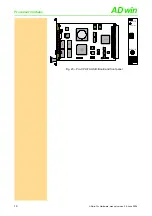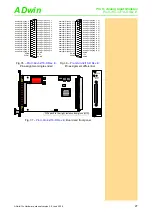
Pro II: Analog Input Modules
Pro II-AIn-F-8/14 Rev. E
ADwin
28
ADwin-Pro
Hardware, manual version 2.9, June 2006
5.3.3 Pro II-AIn-F-8/14 Rev. E
The analog input module
Pro II-AIn-F-8/14 Rev. E
has 8 Fast-ADC of 14 Bit
and 8 differential inputs.
The inputs are available with the following connectors:
– Pro II-AIn-F-8/14-L2: shielded LEMO-sockets, 2-pole, CAMAC Euro-
pean norm.
– Pro II-AIn-F-8/14-D: DSub socket 37-pin.
– Pro II-AIn-F-8/14-B: BNC-sockets.
The module’s converters run stand-alone with a fixed clock rate of 50MHz. The
module memory enables to buffer a great amount of data–especially with burst
sequences.
The module provides several operation modes for converting analog signals:
– Single measurement: The module converts stand-alone (with fixed
clock rate). The
ADbasic
program queries the current measurement
value and processes them.
– Single burst sequence: The
ADbasic
program starts a compelete burst
measurement sequence, that is a defined number of single measure-
ments.
– Continuous burst sequence: The
ADbasic
program starts a burst mea-
surement sequence, that continuously does single measurements until
the sequence is stopped. The data is stored in a fifo-like memory.
The module
Pro II-AIn-F-8/14 Rev. E
has an input voltage range of ±10V. The
adjustment of gain and offset is made by software. (see
As an option, the module can return the moving average of 2…32 measure-
ment values instead of simple measurement values.
Burst Sequence
The module processes burst sequences independent from the processor mod-
ule of the
ADwin
system. The measurement values–number and measuring
rate to be defined ahead in the program–are stored in the burst-memory of the
module. The processor module then reads the stored values (even during a
burst sequence) and processes them.
With a continuous burst-sequence the measuring rate must be syntonized to
the reading rate. Please note:
– Measurement values are always read in blocks, the block size is select-
able. The greater the data blocks are, the faster the average reading is
done.
Look out: While a block is read, other processes even with higher priority
may be delayed. The probability of a delay rises with the block size.
– The time offset between continuous conversion and blockwise reading
demands a data buffer. Therefore, the initialization of the burst
sequence must allocate sufficient memory range (
P2_BURST_INIT
,
parameter
samples
).
Event Inputs
With module version Pro II-AIn-F-8/14-D Rev. E (DSub socket) a burst
sequence can be controlled by external event signals, i.e. each (resulting)
event signal has a measurement value stored.
As an option one channel of the burst sequence may be used as time channel,
which holds the counter value of the internal module timer for each event sig-
nal.
















































